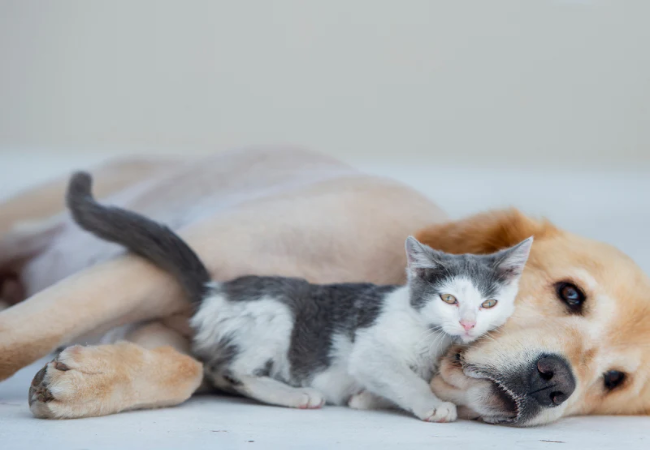A Vet’s Guide to Introducing a Cat to Your Dog: Step by Step, Safe & Stress Free 2025 🐱🐶

In this article
A Vet’s Guide to Introducing a Cat to Your Dog: Step by Step, Safe & Stress Free 2025 🐱🐶
By Dr. Duncan Houston BVSc
Hello! I’m Dr Duncan Houston BVSc, veterinarian and founder of Ask A Vet. Bringing a cat and dog together can build a beautiful bond—but it needs patience, planning, and clear steps. This vet‑approved guide covers how to introduce them gradually to minimize stress and risk, and Ask A Vet telehealth services in 2025. 🩺🐾
1. Why Introductions Should Be Slow
Cats and dogs are wired differently—dogs may chase, while cats may flee or fight back. A slow, structured introduction reduces stress and the chance of injury.
2. Pre‑Introduction Prep: Build Comfort
- 🐾 Set up separate “safe spaces”—a cat-only room and a dog success zone, both with food, water, bedding, toys, and a litter box for cats.
- 🔁 Swap scents—exchange bedding or rub towels on both pets and place in each other's spaces—familiarity builds trust.
- 🍽️ Feed near shared door—so they link presence of the other with positive experiences.
3. Step 1: Sight Without Contact
- 🚪 Use baby gates or cracked doors—let them see but not reach each other.
- 🧑🤝🧑 Have two handlers—one per pet, both calm and attentive.
- 🎾 Distract with treats/toys—keep both calm and rewarded during sight exposure.
4. Step 2: Desensitized Viewing
- 🪟 Short supervised viewings through barrier—a few minutes several times daily.
- 👁️ Play “Look At That” training with the dog—reward attention shift away from the cat.
- 📏 Increase duration gradually only if both stay calm.
5. Step 3: On‑Leash Face‑to‑Face
- 🐕🦺 Keep the dog leashed; let the cat approach freely.
- ✅ Dog should be rewarded for calm behavior; cat should have escape routes and vertical perches.
- ⚠️ If either acts fearfully or aggressively, separate and revert to the previous step.
6. Step 4: Supervised Interaction
- 🛋️ Remove toys/food that trigger resource guarding.
- 🙏 Keep sessions short (5–10 min) and calm.
- 🎥 Use monitoring or a pet cam for unsupervised checks after multiple peaceful sessions.
7. When Things Don’t Go Smoothly
- 💼 Some pairings may never fully integrate—keep the cat’s sanctuary available.
- 🛋️ Reset to an earlier step if stress flares; it's normal and repairable.
- 👥 Get professional help if aggression or too much fear persists.
8. Supporting Tools & Enrichment
- Ask A Vet App: Send videos of interactions and get telehealth advice on pacing and next steps.
9. Real Vet Case
Case: Luna (cat) & Milo (Labrador pup)
Luna hid anytime Milo roamed freely. We started with scent swapping, then barrier viewing during feed times. Milo learned “look at that” and focus cues. After a slow build, on‑leash visits allowed Luna’s curiosity to emerge. Now, 3 months later, they nap in the same room. Their owner credits the slow method, Woopf distractions, and Ask A Vet check-ins for their peaceful coexistence.
10. FAQs
-
Can kittens and puppies meet?
Yes—young ages under 12 weeks tend to adapt best, but proceed stepwise. -
What breeds are cat‑friendly?
Breeds like Golden Retrievers, Beagles, and Poodles typically handle introductions well. -
What if my dog has a high prey drive?
Go slower, use "look at that" techniques, and consider expert training.
📌 Final Thoughts from a Vet
With patience, structure, and support, many cats and dogs build harmonious relationships. The key? Let them set the pace, use barriers and positive associations, and support calm behavior with tools like Ask A Vet. When in doubt, prioritize safety and seek professional help—your vet, behaviorist, or Ask A Vet telehealth. Here’s to a happy, multi‑species home in 2025! 🐾❤️






